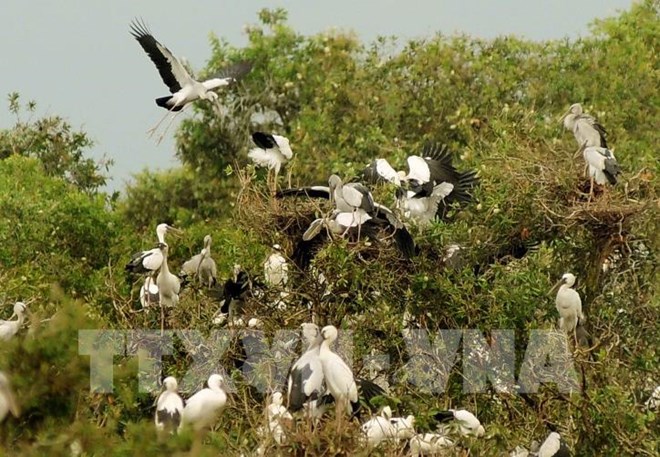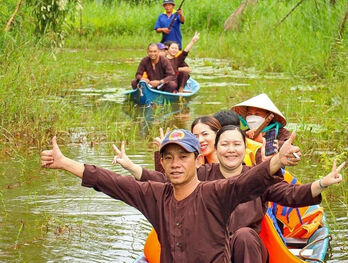
Birds flock to Tram Chim National Park. (Photo: VNA)
The figure was released at a July 19 seminar on bio-diversity preservation in Tram Chim, which was organised by the Dong Thap People’s Committee and the International Union for Conservation of Nature (IUCN).
The park, flooded for half the year and dry for the other six months, spans more than 7,300 hectares in Tam Nong district. It is home to 250 species of water birds, 100 species of freshwater fish and 190 species of plants.
At the seminar, Nguyen Hoang Minh Hai, head of the park’s office for science and international cooperation, said conservation work has helped recover 192 hectares of grass-like sedge and eastern purple bladderwort in addition to a number of indigenous plants. Birds’ eating areas have been improved, while more sites were created for their nesting.
According to Hai, researchers have discovered 36 aquatic species via monitoring fish travelling in and out of sewers and found 71 more plant species. They also released more than 10 fish species into the park.
He said future preservation work focuses on personnel adjustment of the park’s wetland advisory group and allows suitable usage of its natural resources, helping locals improve livelihoods during the flood season.
Duong Van Ni from Can Tho University’s faculty of environment and natural resources pointed to major impacts on the park’s bio-diversity. They consisted of ecosystem changes, overexploitation, pollution, diseases, invasive species and climate change.
He said priority should be given to the development of grass fields then to Melaleuca forests, while the water level should not be left high for a long period of time.
Le Phat Quoi from the Ho Chi Minh City centre for environment and ecosystem sciences suggested solutions to improve soil quality in the park’s A1 section to expand the area of grass-like sedge, wild rice and other plants to attract cranes and other bird species.
He said canals should be linked together to avoid alum formation in the water.
The Tram Chim National Park is the fourth Ramsar site of Vietnam and the 2,000th Ramsar site of Wetlands of International Importance in the world.
The park has become a destination for both domestic and foreign tourists. In 2017, it welcomed more than 134,000 visitors, a year-on-year surge of 28.87 percent.
The World Wide Fund for Nature in Vietnam provided 2.6 billion VND (114,000 USD) for a project encouraging eco-tourism and sustainable use of natural resources in the park in 2017./.
VNA
 Mekong Delta ramps up cultural, tourism events to hit visitor goals
Mekong Delta ramps up cultural, tourism events to hit visitor goals



